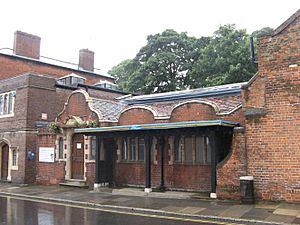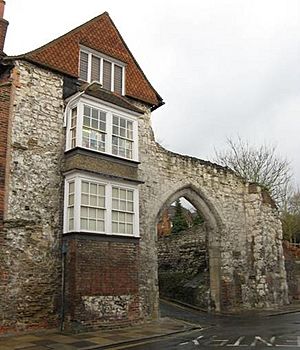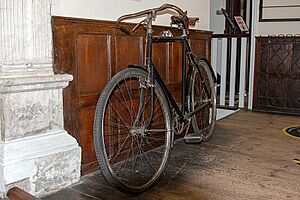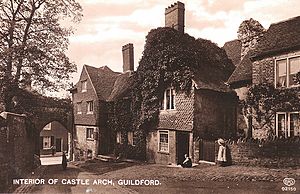Guildford Museum facts for kids
Quick facts for kids Guildford Museum |
|
|---|---|

Guildford Museum Quarry Street Entrance
|
|
| Location | Quarry Street, Guildford, Surrey |
| OS grid reference | SU 99695 49249 |
| Governing body | Guildford Museums |
| Owner | Guildford Borough Council |
|
Listed Building – Grade II*
|
|
| Official name: Castle Arch | |
| Designated | 1 May 1953 |
| Reference no. | 1189846 |
|
Listed Building – Grade II*
|
|
| Official name: The Castle Gateway | |
| Designated | 1 May 1953 |
| Reference no. | 1029253 |
| Lua error in Module:Location_map at line 420: attempt to index field 'wikibase' (a nil value). | |
The Guildford Museum is the main museum in the town of Guildford, Surrey, England. You can find it on Quarry Street, a narrow road with old cottages. This street is just off the main High Street, which is only for people walking. The museum is part of the old gatehouse and other buildings of Guildford Castle. The museum staff also help to manage the castle. Guildford Borough Council runs the museum. It's free to enter from 11 am to 4:45 pm, Monday to Saturday. The museum is closed on Sundays and on Christmas Day.
Contents
A Look Back: Museum History
The museum's collection started with the Surrey Archaeological Society, which began in 1854. This group collected objects from digs and gifts. They also borrowed items from people. At first, these items were kept by the Society's secretaries in different places in London.
Finding a Home for the Collection
In 1871, someone suggested moving the collections to Croydon. Croydon was part of Surrey back then. The Croydon Literary and Scientific Institute offered to store the items for free. They also promised to provide display cases and make a list of everything. The Society thought this was a great deal.
However, the Institute did not take good care of the collections. In 1892, the Society's secretary, Mill Stephenson, found the items in a "deplorable condition." Glass cases were broken, locks were smashed, and some objects were damaged or even missing. The Society then had to find a new home for their collection.
Moving to Guildford Castle
Luckily, Guildford Borough Council offered help. The Council had bought Guildford Castle and its grounds in 1885. They opened it as a public park. The castle grounds included some cottages where the old gatehouse used to be. In 1898, these cottages were offered to the Archaeological Society. They became the new museum and library. The rent was £12 per year. As part of the deal, the Society agreed to open the museum to the public at least one afternoon a week.
In 1903, Fredrick H. Elsley became the joint Librarian and Curator. He looked after the Society's books, old papers, and objects.
Growing and Changing
By 1912, the museum was funded by both the Society and the Borough Council. It became known as "The Guildford Borough and Surrey Archaeological Society Museum." People could now visit for free three afternoons a week. In 1933, the Council took over running the museum completely. The Society's collection stayed there on a long-term loan.
In June 2009, the museum joined with the local Art Gallery.
What's Inside: Museum Collections
Guildford Museum looks after more than 75,000 objects! These items date from around 500,000 BC (a very old time called the Lower Palaeolithic) all the way to today. The museum mostly collects objects from Guildford and Surrey. They usually don't accept items from outside this area.
The collections are divided into four main parts:
Archaeology: Ancient Discoveries
The archaeology collection started in 1854. Many items in this collection have been there for over 100 years. Some of the most interesting items include:
- Sceptre handles and special hats from a Romano-British temple site in Wanborough.
- A large group of Mesolithic handaxes from Farnham. These are ancient stone tools.
- All the items found during the dig at the Tudor site of Farnborough Hill Convent. The museum even published a book about it called Pots and Potters in Tudor Hampshire.
The museum also has some of the 6,705 coins from the Reigate hoard. This was a huge collection of medieval coins found in 1990. It included silver and gold coins from 1272 to 1455. There were coins from England, Scotland, France, and eight other countries!
Local History: Stories of Guildford
The local history collection began in 1905. It tells the story of people's lives in Guildford. In 1907, Gertrude Jekyll, a famous garden designer, gave her entire collection of "Old Surrey" objects to the museum. Many of these items are still on display. Some cool things you can see are:
- A napkin with an embroidered picture of Queen Elizabeth I. People believe she actually used it!
- Pieces of a Zeppelin bomb that fell on Guildford during World War I.
- A green velvet suit bought in Carnaby Street, London, in the 1970s.
Needlework: Stitched Art
The museum also has a special collection of needlework. This includes:
- Samplers from the 1700s and 1800s. These are pieces of cloth with different stitches to show off sewing skills.
- A "lending quilt" from a local church.
- Many Surrey Smocks. These were special shirts worn by farm workers in the 1600s, 1700s, and 1800s.
Art: Local Artists
Since the museum joined with Guildford House Art Gallery in June 2009, the staff also look after Guildford Borough Council's art collection. This includes paintings by John Russell, an artist born in Guildford.
Museum Location and Buildings
Guildford Museum is on Quarry Street, almost across from St Mary's Church. St Mary's Church is the oldest building still standing in Guildford, built around the year 1000.
The first building the museum used was Castle Arch. Its foundations are part of the old gatehouse to Guildford Castle. The museum moved into Castle Arch in 1898. In 1911, the building got bigger. An extension was built in the Castle Arch gardens to hold Gertrude Jekyll's "Old Surrey Life" collection.
The museum grew again in 1927. The Borough Council bought 48 Quarry Street, a house from the 1800s. They turned it and the land next to it into a special room for the Archaeological Society's old papers and records.
Exhibitions: What's New to See?
The museum always has new temporary exhibitions. These shows change regularly. Some recent exhibitions have included:
- "Hidden House Histories": This show looked at objects hidden in houses long ago, often for good luck.
- "The Women's Royal Army Corps in Guildford": This exhibition covered the time the WRAC had its main office in Guildford (from 1949 to 1992).
A past exhibition called "A Few of My Favourite Things" was very popular. Local people chose objects from the museum's stored collections to put on display. Some of the guest curators included Anne Milton MP and Bishop of Guildford Christopher Hill. Items shown included a 400,000-year-old hand axe from Kent and a napkin used by Queen Elizabeth I. This napkin has her embroidered picture and an image of St George fighting the Dragon.
Public Services: How the Museum Helps You
It's free to enter the museum and see its collections. You can also see items not on display by making an appointment. The museum offers a service to help people identify objects they find. They also have "school loans boxes" for schools and groups. These boxes let you use real objects during lessons or meetings.
Next to the museum, there's a Victorian schoolroom. Here, children aged 6–12 can experience what school was like in Victorian times. Museum staff can also be booked to give talks about the history of Guildford and Surrey.
See also
- Surrey Archaeological Society
- Surrey History Centre




